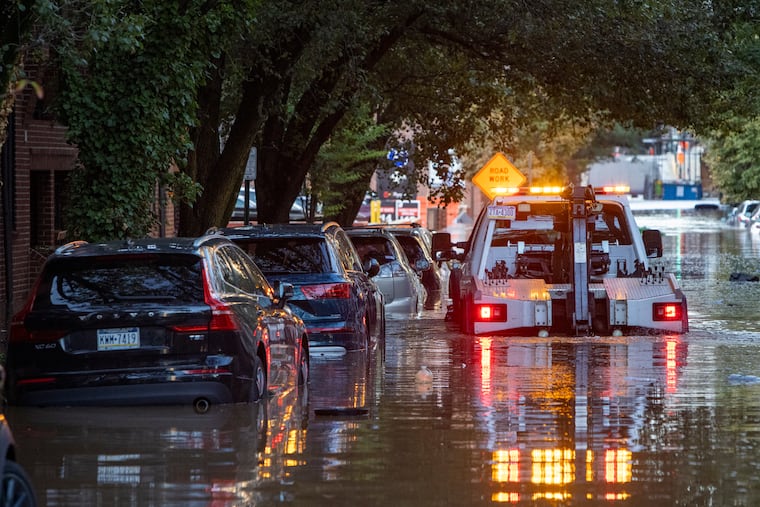AccuWeather VP: If Hurricane Ida had been snow, Philly officials might’ve heeded our warnings | Opinion
Because this was a rainstorm, proper preparations were not taken, even though heavy rainstorms have killed more people than snowstorms.

The wide-ranging impacts to people, businesses, and communities caused by Hurricane Ida from the Gulf Coast to the Northeastern states have been truly heartbreaking to witness. Lives have been changed forever, and tragically too many are now lost.
Ida’s devastation is a reminder and important call to action to make needed adjustments to how we as a society plan, prepare for, and react to natural disasters. This need is heightened by increasing weather volatility and the frequency of extreme weather events around the globe, driven by climate change, as noted in the Intergovernmental Panel on Climate Change (IPCC) report.
But weather professionals alone can’t save lives. We need the help of local and state elected officials to amplify severe weather warnings and coordinate, communicate, and implement emergency plans before the disaster gets to the point of no return.
» READ MORE: Hundreds of Philly-area residents lost their homes in Ida. In one town, they wonder if they can ever rebuild.
The forecasts and warnings about Ida and its associated devastating impacts were clear and accurate, days in advance, every step along Ida’s track. When compared with Hurricane Camille and other hurricanes of decades past, the number of lives lost would have been much higher if not for the highly accurate and actionable lifesaving warnings provided by today’s forecasting community.
AccuWeather meteorologists applied cutting-edge science to benefit communities from Louisiana and the Gulf Coast to the Northeast, including predicting 4 to 8 inches of rain expected to come “fast and furious” within just a few hours. In New York City, Philadelphia, and the surrounding I-95 corridor, AccuWeather forecasters intentionally used strong language to communicate the risk, warning of “significant flash flood risk, watch for rapidly rising waters,” and later, “major, widespread and life-threatening flash flooding.” The National Weather Service issued a rare “high” risk for flash flooding in the Northeast the day before Ida arrived, along with flash-flood watches. WPVI in Philadelphia warned its audience in advance to brace for dangerous flooding to come regarding Hurricane Ida.
Even with a great forecast, however, clearly, we all must do more to protect people and improve our resiliency. Despite all of the advance warnings, neither Mayor Jim Kenney in Philadelphia nor Bill DeBlasio in New York issued a travel ban, for example, ahead of Ida. Why did life continue on as normal?
Northeastern cities have an entire response infrastructure activated routinely in advance of snowstorms, meant to minimize damage, injuries, and deaths. Had the forecast called for 4 to 8 inches of snow, especially coming down at several inches per hour, no doubt there would have been a near shutdown of major metropolitan cities, including event and flight cancellations — in addition to travel bans and many other restrictions and warnings to protect people.
Because this was a rainstorm, proper preparations were not made in advance, even though storms that produce copious amounts of storm surge and/or flooding rain have historically been responsible for more fatalities than have snowstorms.
» READ MORE: Ida’s fatal power didn’t shock scientists who study how climate change primed the pump
In Philadelphia and its suburbs, more than 450 water rescues were carried out, but ultimately five lives were lost. A travel ban was never issued; instead, warnings to evacuate and avoid areas with dangerous flooding were shared by officials after the fact. Initiating a travel ban and evacuating occupants before the rain had started, based on the forecast, would have saved lives.
Elected officials must develop the same type of response framework used successfully for snowstorms for extreme rainfall and other severe weather events. Ironically, many of these same electeds often highlight the need for action related to climate change, however it does not seem this has yet translated into needed improved resiliency for extreme weather events.
The issue of infrastructure must also be reexamined closely as it relates to threatening weather. While Katrina in 2005 was an infrastructure disaster because of the failed water protection system, Ida was an infrastructure nightmare because of the catastrophic power failure. Louisiana residents have endured, in some cases weeks, without power in the hot and steamy late summer weather – a further risk to lives and health that has amplified suffering. The Schuylkill and the Perkiomen Creek reached their highest levels in recorded history and overflowed. Water from the Schuylkill inundated nearby roadways, homes, and even plunged a major SEPTA line underwater.
In almost every severe storm, we see that city infrastructures are not ready for today’s weather extremes.
These challenges provide real opportunity to take seriously the increasingly accurate and actionable weather forecasts, and drive better outcomes. No matter the disaster, one of the great things about Americans is our ability to take a critical look at disastrous situations and determine how to work together to make improvements, so next time we can better “weather the storm.” Now is our opportunity to learn from Ida. Lives can be saved in the future, human suffering can be reduced, and our country will become more resilient as a result.
Jonathan Porter is senior vice president of forecasting operations and chief meteorologist at AccuWeather. He has been at State College-based AccuWeather since 2004 and oversees all forecasting, content, and graphics operations.